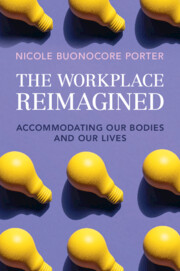Book contents
- The Workplace Reimagined
- The Workplace Reimagined
- Copyright page
- Dedication
- Contents
- Preface
- Acknowledgments
- 1 Introducing a Workplace Reimagined
- 2 The Caregiver Conundrum
- 3 People with Disabilities in the Workplace
- 4 Intersections
- 5 The Entrenchment of Structural Norms
- 6 Special Treatment Stigma
- 7 Theoretical and Practical Justifications for the Reimagined Workplace
- 8 The Workplace Reimagined, Part I
- 9 The Workplace Reimagined, Part II
- Bibliography
- Index
1 - Introducing a Workplace Reimagined
Published online by Cambridge University Press: 11 May 2023
- The Workplace Reimagined
- The Workplace Reimagined
- Copyright page
- Dedication
- Contents
- Preface
- Acknowledgments
- 1 Introducing a Workplace Reimagined
- 2 The Caregiver Conundrum
- 3 People with Disabilities in the Workplace
- 4 Intersections
- 5 The Entrenchment of Structural Norms
- 6 Special Treatment Stigma
- 7 Theoretical and Practical Justifications for the Reimagined Workplace
- 8 The Workplace Reimagined, Part I
- 9 The Workplace Reimagined, Part II
- Bibliography
- Index
Summary
Chapter 1 introduces the concepts and ideas I discuss throughout this book. First, I provide a summary of the experiences of both individuals with disabilities and workers with caregiving responsibilities in the workplace. This summary exposes the difficulties these two groups have when trying to meet the expectations of their employers. Second, I introduce some of the laws and legal concepts that are discussed throughout the book—the Americans with Disabilities Act, reasonable accommodations, sex discrimination under Title VII, the Pregnancy Discrimination Act, and the Family and Medical Leave Act. Third, I briefly explain my proposal for reform. Finally, this chapter provides a brief outline of the structure of the rest of the book.
Keywords
- Type
- Chapter
- Information
- The Workplace ReimaginedAccommodating Our Bodies and Our Lives, pp. 1 - 14Publisher: Cambridge University PressPrint publication year: 2023

